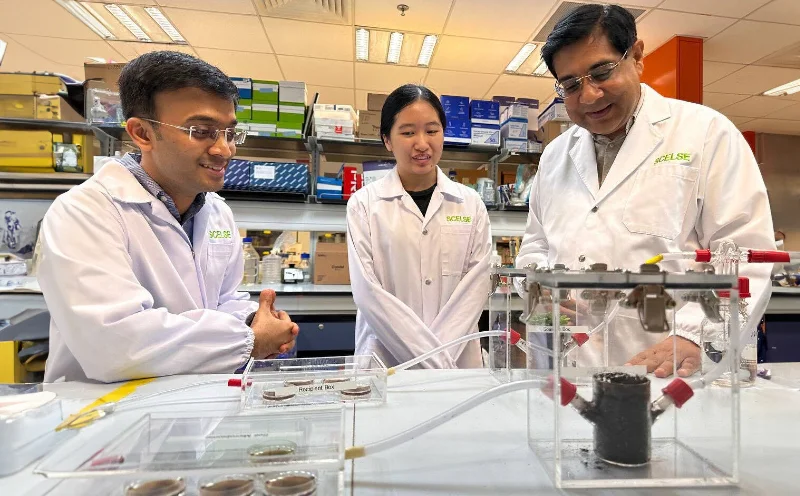Scientists from the National University of Singapore (NUS) and the Singapore Center for Environmental Life Sciences Engineering (SCELSE) have unveiled a remarkable plant hormone that can supercharge growth by a staggering 30%.
This discovery opens a new avenue for addressing the challenges faced by modern agriculture, offering a potent solution in the form of agro-microbials—natural agro-chemicals that foster a symbiotic relationship between crops and microbes, thereby bolstering crop yield and overall productivity.
Over the course of a rigorous five-year study that began in 2018, the researchers unearthed a hidden facet of a well-known plant hormone, methyl jasmonate (MeJA), typically released by plants above ground during times of stress. Surprisingly, MeJA, which is a volatile organic compound (VOC), was found to possess an unprecedented function.
As it turns out, MeJA acted as a clandestine means of communication, enabling plants to converse with the subterranean community of microorganisms residing in the soil.
This groundbreaking research yielded three pivotal revelations:
- Using an innovative airflow system, scientists established, for the first time, that MeJA is emitted underground by plant roots in a volatile form.
- The presence of volatile MeJA triggers and augments the formation of biofilms in bacteria situated at a distance from the plant roots.
- These biofilm-embedded bacteria release a distinct set of volatile compounds that can enhance plant growth by an astounding 30%.

These findings were presented in a paper titled “Volatile methyl jasmonate from roots signals the formation of host-beneficial biofilms by the soil microbiome,” which was published in the journal Nature Chemical Biology on November 13, 2023.
Associate Professor Sanjay Swarup, a Principal Investigator at the Research Center on Sustainable Urban Farming (SUrF) within the NUS Faculty of Science and Deputy Research Director at SCELSE, emphasized the far-reaching implications of this discovery. He remarked, “The significance of this revelation is multifaceted and pivotal for sustainable agriculture. By harnessing these agricultural microbes, we can not only amplify crop productivity but also reduce our reliance on synthetic inputs, mitigating the environmental repercussions of contemporary farming practices.”
With the knowledge of this natural mode of communication between plants and beneficial microbes, the research team has taken the initiative to patent the application, aiming to further enhance agricultural resilience and productivity. This could herald a new era of agro-chemicals or nature-derived compounds designed to amplify plant benefits.
The video above gives a brief walkthrough of the research findings by the team. Credit: National University of Singapore
Agro-microbials: Shaping Plant Growth and Ensuring Food Security
As the global population is projected to reach 10 billion by 2050, being able to feed everyone using a consistent food supply has become a top concern. Singapore, for instance, has set an ambitious “30 x 30” target—to produce 30% of its nutritional needs by 2030.
To attain these objectives, agricultural productivity must urgently contend with the challenges posed by climate change, land degradation, and increasingly unpredictable weather patterns. Enter agro-microbials and nature-based agrochemicals, which are emerging as promising solutions for sustainable agriculture.
Agro-microbials encompass microbial communities associated with crops, playing vital roles in promoting plant growth, preventing diseases, and facilitating nitrogen fixation. They also contribute to soil fertility by decomposing organic matter, recycling nutrients, and creating humus to retain moisture. These diverse agro-microbial communities are found within biofilms, where they are embedded in a self-produced matrix.

The 'Fragrant' Emission from Plant Roots: A Cascade of Positive Effects
The fragrant MeJA VOC has the remarkable ability to influence microbes even at a distance from the plant. This underscores the far-reaching nature of this signaling mechanism, extending beyond the immediate vicinity of the plant’s root system, known as the rhizosphere.
Dr. Omkar Kulkarni, one of the paper’s joint first authors, who now serves as a research scientist at the L’Oréal-SCELSE joint laboratory, remarked, “Plants may not communicate like humans, but they possess their own elegant means of long-distance interaction. This exciting discovery not only deepens our understanding of plant-microbe interactions but also holds the potential to pave the way for the development of nature-based agrochemicals.”
Dr. Kulkarni conducted this research as part of his Ph.D. work at the Department of Biological Sciences of the NUS Faculty of Science.
Dr. Mrinmoy Mazumder, an NUS research fellow at SCELSE and another joint first author of the paper, added, “VOC-mediated communication between plants and microbes in the rhizosphere spans the distance, orchestrating nature’s harmonious collaboration. This discovery holds fundamental and translational significance for the scientific community, offering opportunities to delve into mechanistic insights and develop tailored solutions for stress management in diverse crop varieties.”
Source: Nature Chemical Biology




















